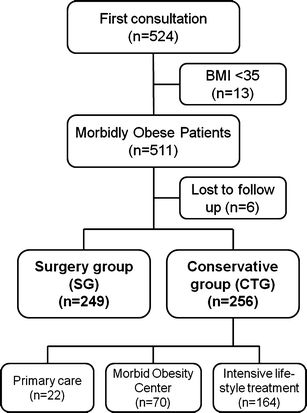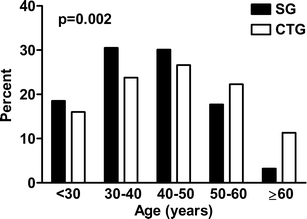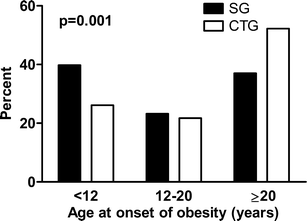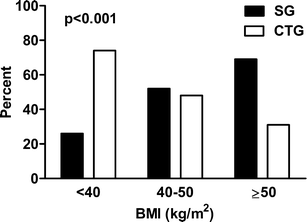Morbidly obese patients--who undergoes bariatric surgery?
- PMID: 20049653
- PMCID: PMC2910888
- DOI: 10.1007/s11695-009-0053-y
Morbidly obese patients--who undergoes bariatric surgery?
Abstract
Background: Bariatric surgery particularly benefits patients with obesity-related comorbidities such as type 2 diabetes and obstructive sleep apnea. We aimed to examine whether the variables that influence treatment choice differ between morbidly obese patients undergoing bariatric surgery and those opting for conservative treatments.
Methods: A total of 505 consecutive morbidly obese patients (72% women; mean (SD) age 42 (12) years) who attended our tertiary care center between December 2005 and February 2007 were examined by a multidisciplinary team and offered surgical or conservative treatment. The chi-square test, independent samples t test, and multiple logistic regression were used in the statistical analyses.
Results: A total of 249 (49%) patients underwent bariatric surgery. When compared to the conservative group of patients, the surgery group was characterized by a significantly higher mean (SD) BMI (46.5(6.2) vs. 43.2(5.5) kg/m(2), p < 0.001), earlier onset of obesity (40% vs. 26% before 12 years of age, p < 0.001), and lower age (41(11) vs. 44(13) years, p = 0.002). In contrast, the groups did not differ significantly with respect to gender or obesity-related comorbidities. After adjustments for gender, age, onset of obesity, and the number of comorbidities, multiple regression revealed that patients with BMI 40-50 or >50 kg/m(2) had between 3 (OR = 3.0; 95% CI 1.9-4.9, p < 0.001) and 6 (OR = 5.7; 95% CI 3.0-11.0, p < 0.001) times the chance of undergoing bariatric surgery when compared to patients with a BMI <40 kg/m(2) (reference).
Conclusion: Our data indicates that increasing BMI rather than obesity-related comorbidities, predicted treatment choice in morbidly obese patients.
Figures




References
-
- Ulset E, Undheim R, Malterud K. Has the obesity epidemic reached Norway? Tidsskr Nor Laegeforen. 2007;127(1):34–7. - PubMed
Publication types
MeSH terms
LinkOut - more resources
Full Text Sources
Medical

